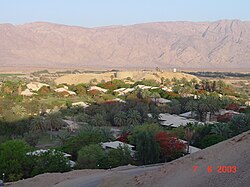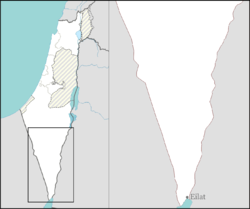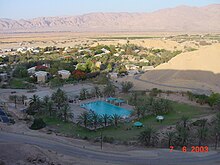| Revision as of 22:39, 21 September 2019 editHuldra (talk | contribs)Autopatrolled, Extended confirmed users, Page movers, Pending changes reviewers, Rollbackers83,885 edits fix dead HA link← Previous edit | Revision as of 02:14, 13 October 2019 edit undoLeitmotiv (talk | contribs)Extended confirmed users18,468 edits underground tunnel is redundantNext edit → | ||
| Line 43: | Line 43: | ||
| * East of the kibbutz lies an ancient Arab resting fortress with towers in its corners, dating from the ] era (±700 AD) and served as a resting station for the convoys crossing the desert.<ref name = "skr" /> | * East of the kibbutz lies an ancient Arab resting fortress with towers in its corners, dating from the ] era (±700 AD) and served as a resting station for the convoys crossing the desert.<ref name = "skr" /> | ||
| * On a hill west of the kibbutz (50 m), there is an ancient fort dating from the ] (c. 12th century BCE). The fort overlooks the wellspring, and is considered to have served the Egyptians copper miners.<ref name="skr" /> | * On a hill west of the kibbutz (50 m), there is an ancient fort dating from the ] (c. 12th century BCE). The fort overlooks the wellspring, and is considered to have served the Egyptians copper miners.<ref name="skr" /> | ||
| * East of the kibbutz to the north and to the south there is a wells-chain (known as ]) connected with |
* East of the kibbutz to the north and to the south there is a wells-chain (known as ]) connected with a tunnel that leads the ] water to the surface. Fugaras is an ancient but sophisticated irrigation system.<ref name="skr" /> | ||
| * North of the kibbutz are found two ancient ] traps. Leopards are known to have inhabited this area.<ref name="skr" /> | * North of the kibbutz are found two ancient ] traps. Leopards are known to have inhabited this area.<ref name="skr" /> | ||
Revision as of 02:14, 13 October 2019
- "Yotvat" is also the Hebrew name for Tiran Island.
| Yotvata Template:Hebrew | |
|---|---|
 Yotvata (Edom Mountains in the background). Yotvata (Edom Mountains in the background). | |
 | |
| Coordinates: 29°53′44.16″N 35°3′36.35″E / 29.8956000°N 35.0600972°E / 29.8956000; 35.0600972 | |
| Country | Israel |
| District | Southern |
| Council | Hevel Eilot |
| Affiliation | Kibbutz Movement |
| Founded | 1951 |
| Population | 743 |
| Website | www.yotvata.org.il |
Yotvata (Template:Lang-he-n, Template:Lang-ar) is a kibbutz in southern Israel. Located on the Arabah road in the southern Negev, it falls under the jurisdiction of Hevel Eilot Regional Council. In 2022 it had a population of 743.
The Arabah valley is an arid desert where the average annual rainfall is less than 30 mm and temperatures often exceed 40 °C (104 °F) in summer, and 21 °C (70 °F) in winter.
Location
Located approximately 40 km north of the Red Sea, Yotvata is the first, biggest, and most prosperous Kibbutz in Hevel Eilot Regional Council. Being relatively far from major urban centers (41 kilometers north of Eilat and 130 kilometers south of Dimona), it is the center of the region, where most regional facilities are based: regional school, regional council offices, community center, sports center, movies and concerts hall and local airfield.
History
Establishment


Yotvata started in 1951 as a Nahal settlement named Ein Radian. In 1957 it was established as the first kibbutz in the southern Arabah region by Ihud HaKvutzot VeHaKibbutzim. The kibbutz is named after an Israelite encampment mentioned in Numbers 33:34 and Deuteronomy 10:7: "…from there they went to Gudgodah, and then to Jotbatha, a land of streaming water." Althme debates over the exact location of the biblical Yotvata (some say that it is closer to the Red Sea near Taba), the idea of a desert oasis for Israelis was in the founders' mind; the local oasis was the Ein Radian wellspring.
The founders, a small group of men and women 20 years of age and just out of the military service, decided to pursue a life of pioneering and built their home in the desert. They had massive challenges presented by the desert: the burning sun, the heat, shortage of water, salty land and water, limited transportation and no secure source of income. They started making all kinds of agricultural trials growing grapes, pomegranates and vegetables; they raised cattle and chickens - all with little success. The dates plantation proved more suitable to the arid conditions.

And then came the initiative to found a dairy that would provide milk to Eilat, which was expected to grow rapidly. Breeding milking cows in the desert was considered an impossible mission. In 1962 the dairy was founded, with four cows, the member who led the vision and the operation was Ori Horazo (1939-1966). The members tried to get funds from the Jewish Agency, but failed. Eventually, they received funding from the Israeli Trade and Industry Minister, Pinhas Sapir. In the first year, the dairy produced 500,000 liters of milk. By 2008, it was producing 62 million liters a year and controlled 63% of the Israeli dairy beverages market (making NIS400 million a year), and 49% of the fortified milk market (making NIS 250 million a year). It employed 130 workers and had 700 cows. The dairies of Kibbutz Yahel, Lotan, and Ketura provide milk for Yotvata.
In 1960 the first children of the community were born, and six years later the school opened with three first graders; today there are 200 kids in the kibbutz, and 600 students from all of the region communities attend Maale Shaharut School (from 1st to 12th grades) in Yotvata.
Archaeology
Judging by the numerous historic forts surrounding the Kibbutz, Yotvata's location was a strategic one:
- Southwest of the kibbutz lies a Roman fortress built during the reign of the Emperor Diocletian (dated ±300 AD) as part of a line of border fortresses (the Limes Arabicus) in the Negev, in order to protect the trade route from marauding Arab nomads.
- East of the kibbutz lies an ancient Arab resting fortress with towers in its corners, dating from the Nabataeans era (±700 AD) and served as a resting station for the convoys crossing the desert.
- On a hill west of the kibbutz (50 m), there is an ancient fort dating from the Iron age (c. 12th century BCE). The fort overlooks the wellspring, and is considered to have served the Egyptians copper miners.
- East of the kibbutz to the north and to the south there is a wells-chain (known as Fugaras) connected with a tunnel that leads the aquifer water to the surface. Fugaras is an ancient but sophisticated irrigation system.
- North of the kibbutz are found two ancient leopard traps. Leopards are known to have inhabited this area.
Economy and community

Yotvata is a cooperative community, where most adult residents work on the kibbutz in production, services or education. The revenues are equally distributed among the members regardless of their position, along the idea of each one gives as much as he can and gets as much as he needs. Most of daily affairs are conducted communally - education, holidays, dining (three meals a day conducted in the commune dining-room are giving the community more relaxed time to get together) and more.
Yotvata Dairy is a milk products factory which provides the kibbutz with its main source of income and occupies the highest number of members.
Agriculture ranks second in terms of income but perhaps first in importance to the community character and pride. Agriculture branches are irrigated land (onions, potatoes, corn, animal feed, garlic and pumpkins), plantations (dates and mangos) and a big and modern dairy farm.
There is also a big road stop shop on the Arabah Road providing refreshments for travelers.
Other small branches are a picturesque horse stable that lies in the date plantation east to the kibbutz and few artistic studios.
All members take turns contributing to the kibbutz service branches - kitchen, dining-room, laundry, security, etc.
The kibbutz gets all its drinking and irrigation water from aquifer wells in the Arabah valley.
Attractions
Yotvata Hai-Bar Nature Reserve is dedicated to reintroducing extinct species mentioned in the Bible, as well as other endangered desert animals, to the wild. It has three parts: a park for herbivorous animals; the Predators Center that displays reptiles, small desert animals and large predators; and the Desert Night Life Exhibition Hall to observe nocturnal animals during their active hours.
15 km south of Yotvata lies Timna valley, where the sandstone and calcareous rock formations present some breathtaking desert features such as the Solomon's Pillars, Mushrooms, Arches and more. Timna is also known for its ancient copper mines.
The area provides many great desert walks including canyons, roman routes, sand dunes, fossil hunting, rock-climbing and more.
References
- ^ "Regional Statistics". Israel Central Bureau of Statistics. Retrieved 21 March 2024.
- "Israel In Numbers" (PDF). Central Bureau of Statistic.
- Deuteronomy 10:7
- http://fr.jpost.com/servlet/Satellite?cid=1212041487654&pagename=JPArticle%2FShowFull
- El'azari, Yuval, ed. (2005). Mapa's Concise Gazetteer of Israel (in Hebrew). Tel Aviv: Mapa Publishing. p. 217. ISBN 965-7184-34-7.
- ^ "Yotvata website".
- Peretz, Sapir (2008-07-30). "איך הפכה יטבתה ממחלבה קטנה בלב המדבר לאחד המותגים החזקים במשק?" [How did Yotvata turn from a small dairy in the middle of the desert to one of the market's strongest brands?]. Globes (in Hebrew). Retrieved 2019-05-27.
- ^ Menachem Marcus (1979). Hevel Eilot Survey. Hevel Eilot Regional Council. pp. 214–220.
- Bard, Mitchell G., ed. (January 2016). "The Eilat Region". Jewish Virtual Library.
- "Israel Antiquities Authority". Archived from the original on 2012-06-06. Retrieved 2011-04-24.
- "The Yotvata Hai-Bar Nature Reserve". Haaretz. 2008-04-16. Retrieved 2008-10-01.
External links
- Official website
- "Hai Bar Animal and Nature Reserve Red Sea Desert". redseadesert.com. Archived from the original on 2008-09-29. Retrieved 2008-10-01.
| Hevel Eilot Regional Council | |
|---|---|
| Kibbutzim | |
| Community settlements | |